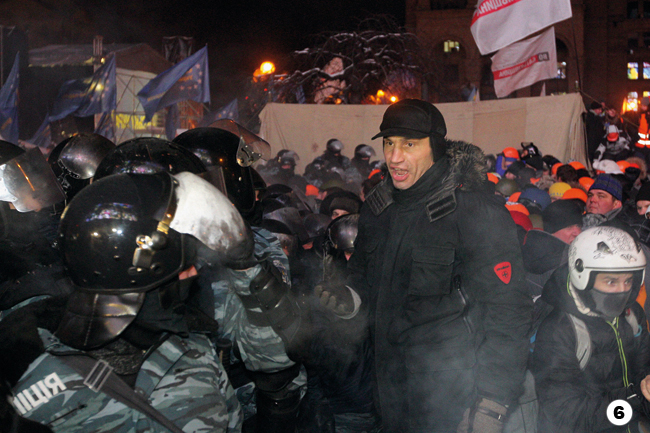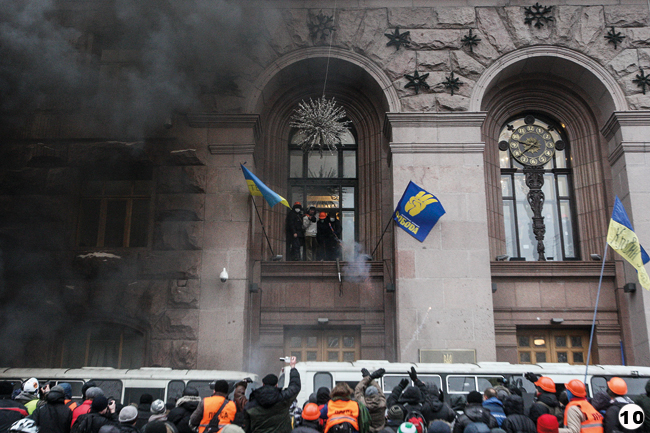December 1. “I’m at a gas station somewhere between Rivne and Zhytomyr at 2 a.m. It has more clients that it usually does during the rush hour,” Yarema Dukh writes on Facebook. “People walk in, go to the bathroom, get a hot sandwich and get back in their cars to carry on to Kyiv. And they are not students, but 40-year old men. Most don’t have Twitter or Facebook accounts but they got up and are driving to Kyiv. They have things to lose. They have people to lose. Hundreds and thousands are going to EuroMaidan. And they are not students. Yanukovych, you’re done – they are not students!”
Closer to noon we are in the metro riding to Kyiv’s city centre. The next stop is Universytet, a downtown station. “Are you getting off at the next stop?” a woman asks people standing in her way in the crowded metro carriage. “Don’t worry, we’re all getting off here,” they reply.
Empty on an average day, Universytet is crowded on December 1. Almost all of the passengers get off and join the sea of people flowing to the escalator. They chant “The villain should go to jail!”, sing the national anthem, call their friends and tell them to get off at stations that are less crowded. All of a sudden, both escalators that go up stop. “Walk!” the crowd urges those who stop, confused. And they obey.
How it all started
Hundreds of thousands took to the streets on December 1, after Berkut’s crackdown on a peaceful student rally on the night of November 30-December 1. That night, Mykhailivsky Monastery (St. Michael’s Monastery) gave shelter to 200 protesters behind its walls. After the crackdown, 35 EuroMaidan activists were arrested and 7 ended up in hospitals. More people went missing for the next couple of days but were later found.
Just a week earlier, protesters felt excitement over the first massive assembly after many years of apathy (EuroMaidan started with small protests on November 21 when the Cabinet of Ministers announced the suspension of preparations for the signing of the Association Agreement, that grew into a 100,000-strong rally on Sunday, November 24 – Ed.). A week later, the crowd was filled with tension and anticipation. The new day brought new rules to play by. Over a hundred thousand Ukrainians who had gathered at the European Square a week before were going to the EU. On December 1, over half a million took to the streets with a different goal in mind: they demanded a change of government. It was no longer about “becoming Europe”. It was about “not becoming Belarus”.
Many expected radical steps from the opposition. As its leaders spoke from stage, angered Ukrainians in the back could barely hear them. Nor could they hear the noise from Bankova Street, where clashes were already taking place in front of the Presidential Administration.
Young unarmed soldiers stood in the first line of the police. “Leave!” the crowd chanted at them, watching as a tractor moved towards them. The soldiers did not move. Nor did the people.
Some of those who stormed the Presidential Administration that day were provocateurs. The infuriated Berkut carefully evaded some others as it chased after protesters. Some were football hooligans, right- and left-wingers standing side by side. And some were students who no longer wanted to dance.
After several hours of clashes with the police, Berkut stormed in to actually disperse protesters with tear gas and a storm of stun grenades, once there were enough injured police officers and excuses to justify its violence.
Injured protesters immediately filled the only ambulance, catering to the needs of the crowd of 2,000 people. The mobile phone signal was weak so the ambulance was unable to call for additional help. The first victims were people injured by exploding stun grenades. “My eye, please save my eye,” a guy with a bleeding face said over and over again. He pulled off his face mask even though it is an essential aspect of anonymity, something quite important in a police state, and partial protection from tear gas. He is under 18 and doctors took him to a children’s hospital. A 22-year old man with a Cossack-style haircut lay nearby, one leg injured by a stun grenade and pieces of it stuck in the other leg. “Does it hurt?” his mother yelled on the phone after she somehow got through to him. “It’s Ukraine that’s hurting, mum,” was his answer.
The ambulance was filled with people that had to be taken to hospital. Doctors could not help others – they had even run out of bandages. The ambulance remained at Bankova while Berkut chased after protesters. People were screaming. A Berkut officer pushed a 40-year old woman against the ambulance door. A young doctor dragged her inside. “Child… my child is out there!” she cried and ran back.
“What the hell are you doing!” the doctor yelled at the Berkut officers chasing after people, pushing them down to the ground and beating them. These officers then took pictures, with their feet resting on the heads of people lying unconscious on the ground, recalls Dnipetrovsk-based journalist Valeriy Harahutsa and others. The three doctors from the ambulance escorted the most seriously injured people to the ambulance and tried to help them. Volunteers brought bandages. Passers-by walked a man to the van, his skull broken and deformed.
The injured were then taken to other ambulances that had finally arrived. The doctor taking them to the trauma unit shook hands with everyone. “You’re great,” he said. “You’re so great guys.” Doctors in hospitals were similarly welcoming.
“They’re still kids,” an old nurse sighs. “No war yet, and kids are already being injured.”
The weekend was over. There were tough days ahead. Protesters went to lick their wounds, picket government buildings, staying at Maidan 24/7 in the thousands, putting barbed wire around barricades, and discussing the provocateurs and the opposition that had failed the revolution.
The next crackdown came on the night of December 11-12. After the Pechersk Court issued a verdict to take measures to prevent the blocking of pedestrian areas and the road around the Maidan, the police and Berkut were brought in and started their crackdown from three directions at around 1 a.m.
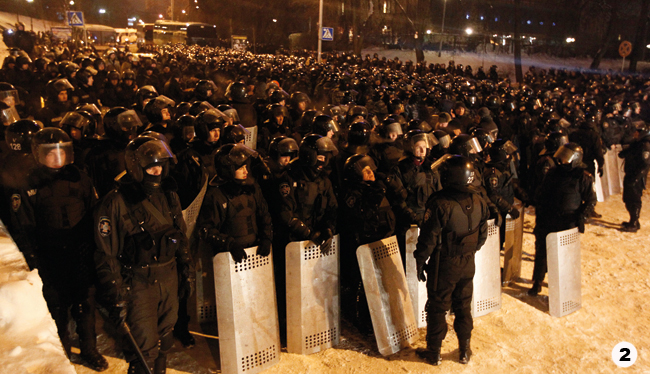
The protesters who occupied the Kyiv City State Administration premises took the women to a safer place and barricaded the building. Berkut stormed through the barricades on the road from the side of European Square and pushed people out. Priests were praying on the stage all the time.

The Afghan veterans protecting barricades on the road from Instytutska Street, which leads to the Presidential Administration, repelled the attack. At this point, there were about 2,500 people on the Maidan and the situation was getting really dangerous.
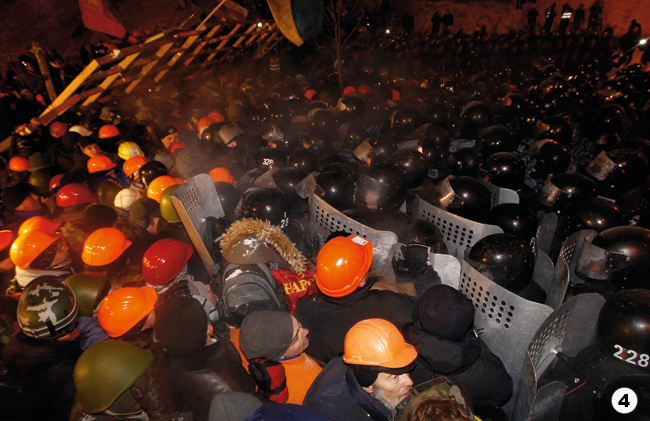
By 3 a.m. there were already twice as many people, as Kyivites arrived even though the authorities made every effort to prevent people from coming. They blocked bridges over the Dnipro and cut off routes to downtown areas. But people continued to arrive. From 4 to 6 a.m. Berkut was brutally pushing people around and used tear gas, yet people continued to resist.
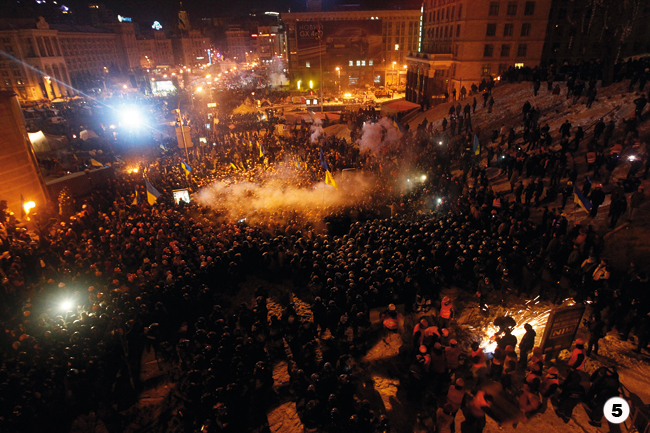
Afghan veterans broke through the Berkut line and cut off half of its troops from the rest of the unit. As the special police began to retreat, the crowd let the captured officers join their lot and got back the territory it almost lost. By that time, the number of protesters had grown to over 15,000. Provocateurs with iron sticks tried to break through to the Maidan and start new clashes but the Maidan security teams found them and chase them out. A group of MPs, including Vitaliy Klitshcko, stood with protesters. By morning, there were more than 20,000 protesters on the Maidan. They began to collect warm clothes and other stuff from the tents that had been brought down by Berkut during the night, when, all of a sudden, three bus-loads of Berkut fighters drove right up to the entrance of the Kyiv City State Administration where there were nearly 200 protesters, and blocked it. In response to Berkut’s attempted storming of the building, protesters poured water over them. Meanwhile, people from the Maidan arrived and encircled Berkut, eventually forcing them to leave. The Maidan survived and more and more protesters arrived, despite regular warnings of bombs in the metro and the closure of central stations.
